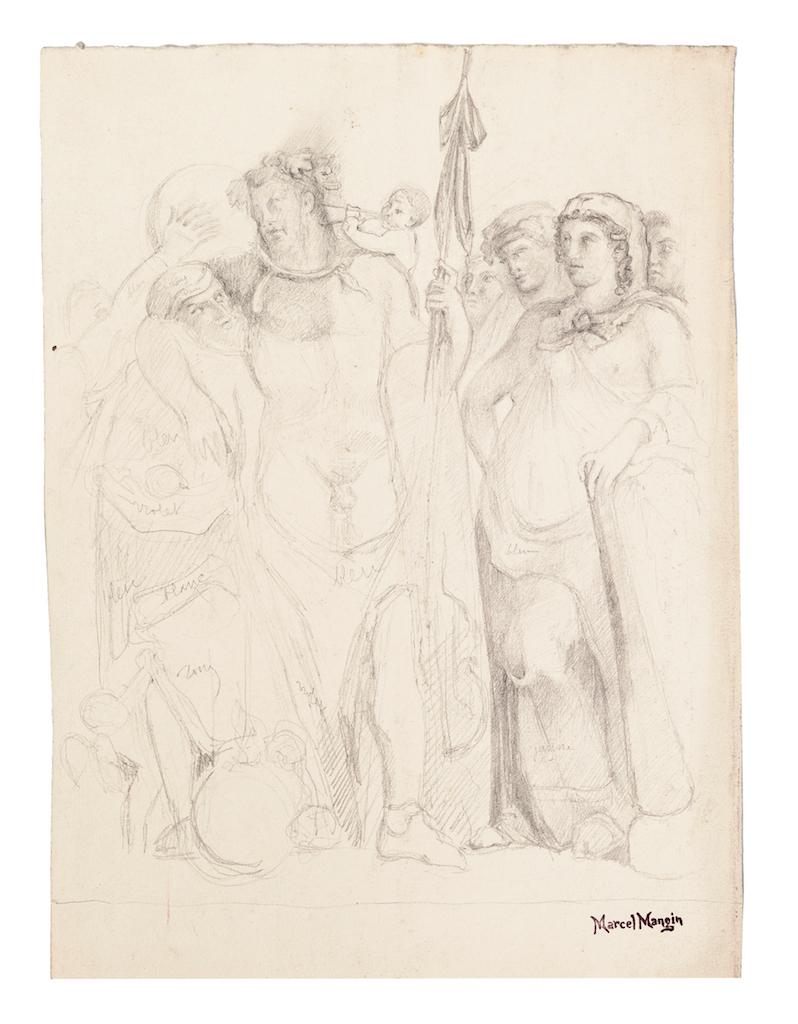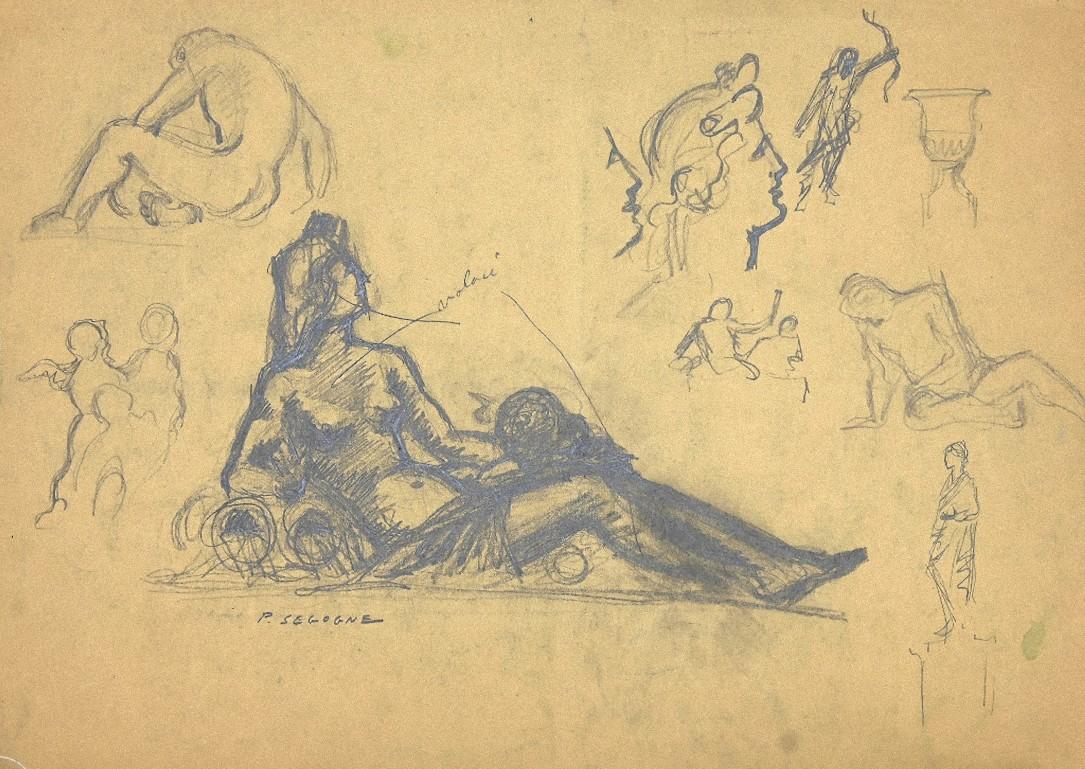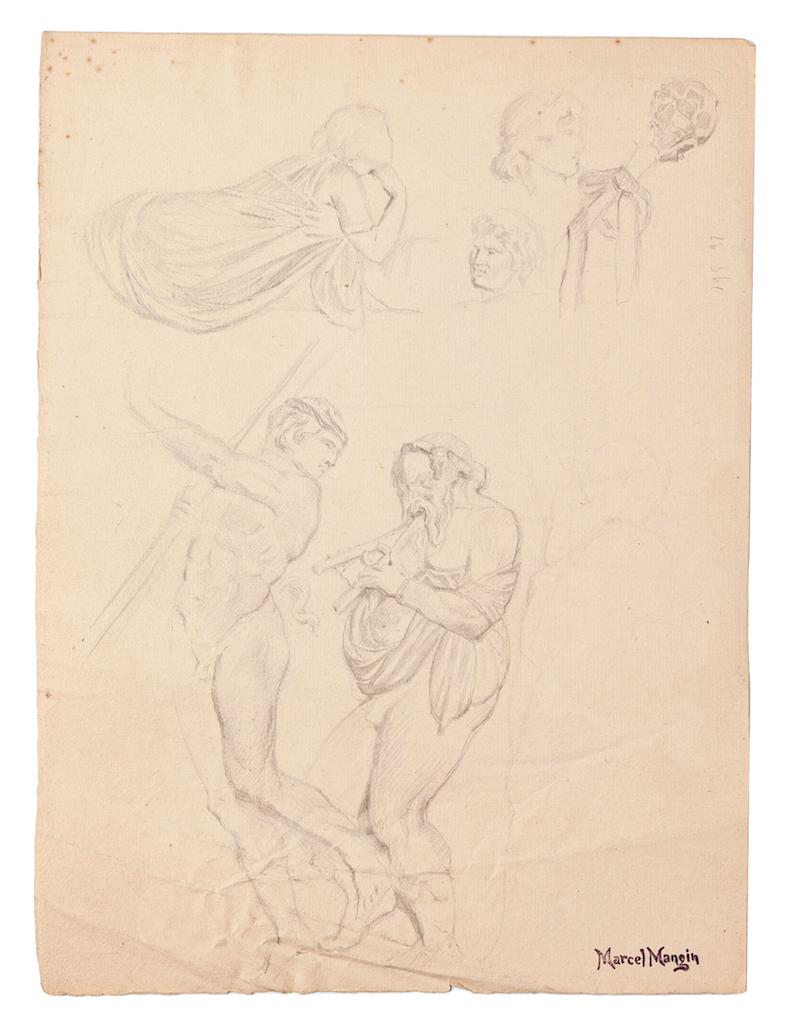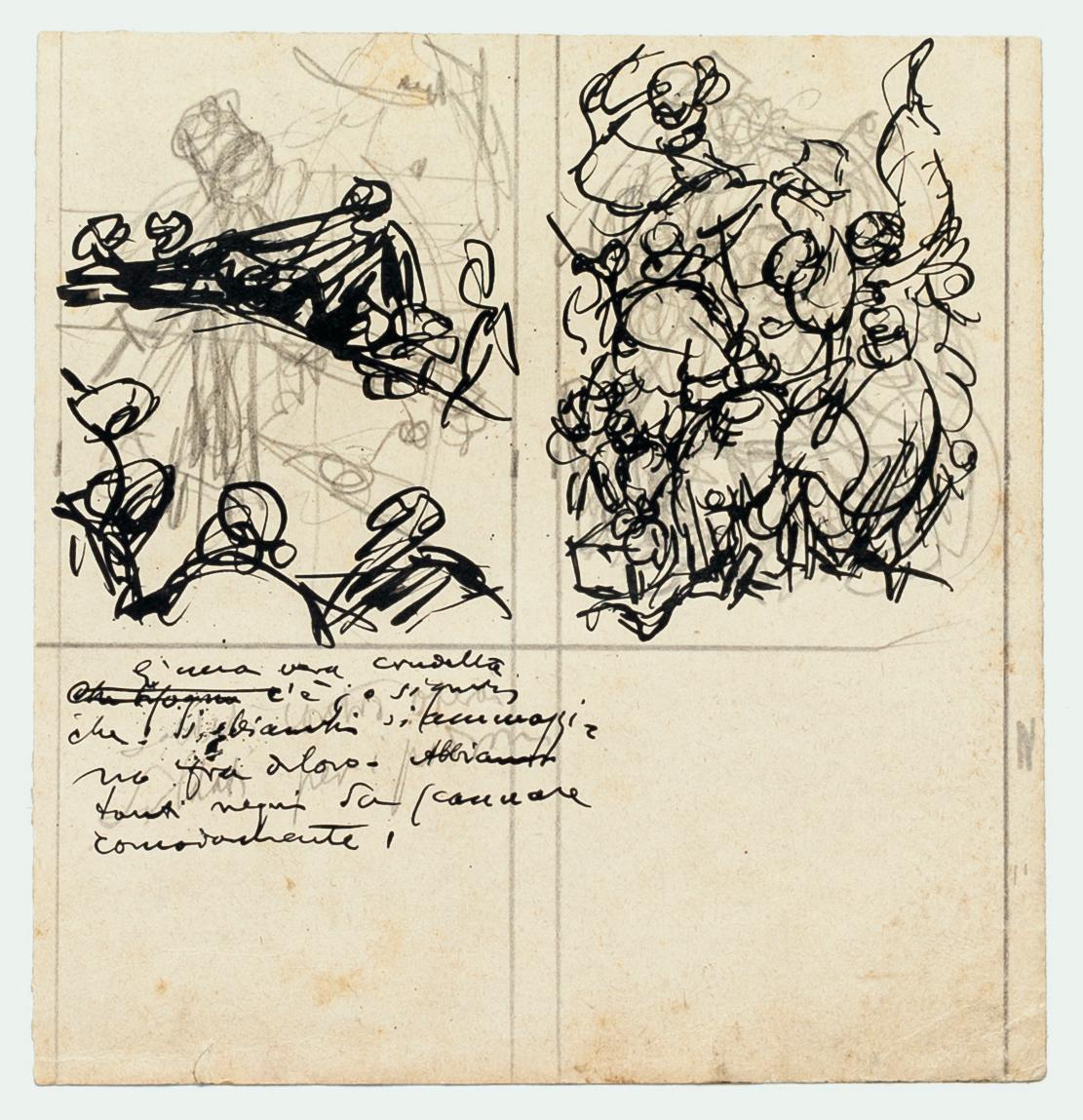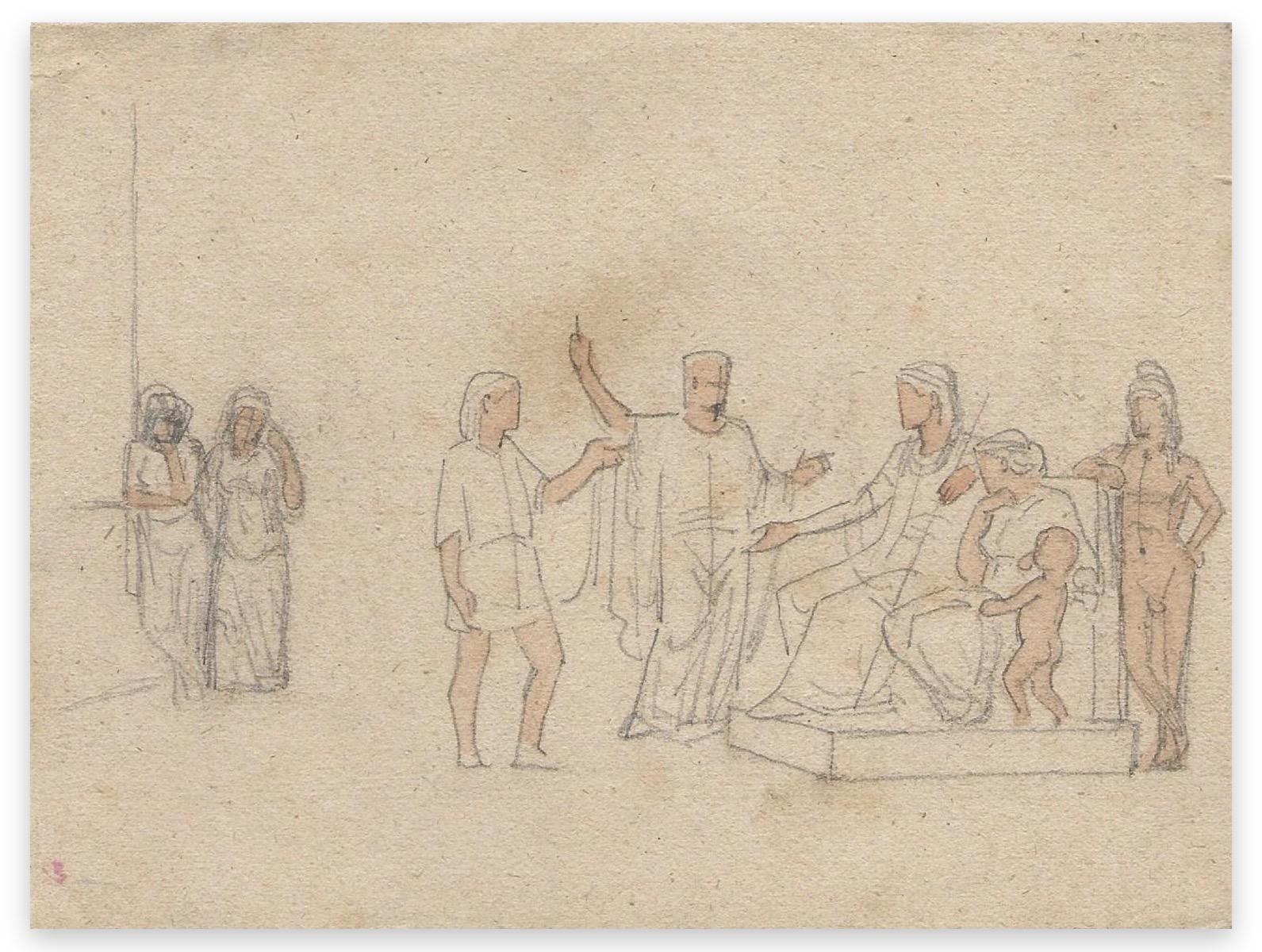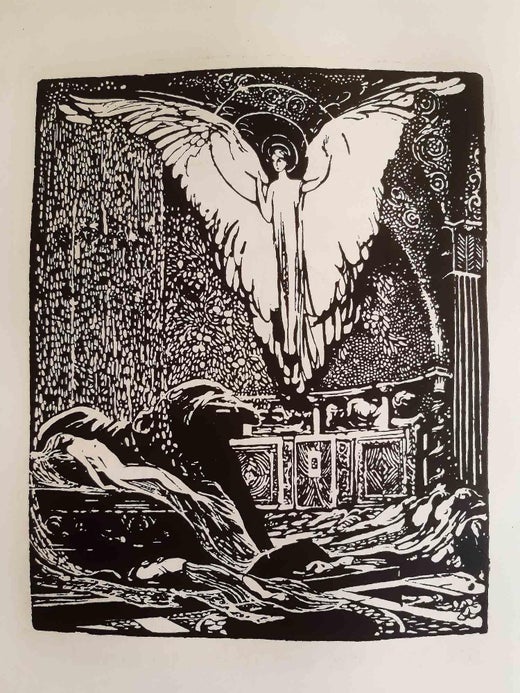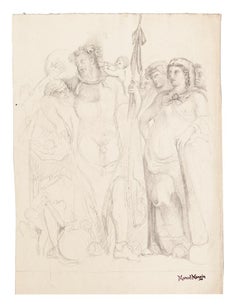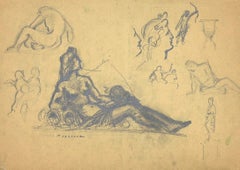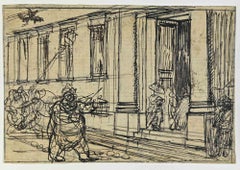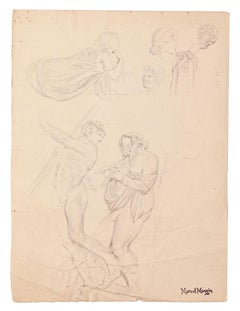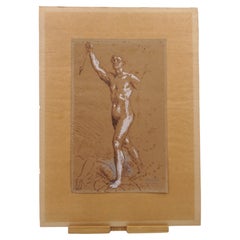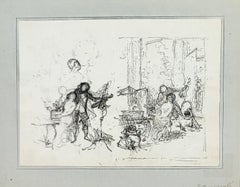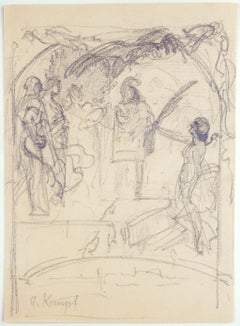Items Similar to Sketch for the Parliament Hall “Thanatos and the Enigma” - 1900s - Drawing
Want more images or videos?
Request additional images or videos from the seller
1 of 8
Giulio Aristide SartorioSketch for the Parliament Hall “Thanatos and the Enigma” - 1900s - Drawing 1908
1908
$8,911.87
£6,624.94
€7,500
CA$12,258.72
A$13,658.03
CHF 7,203.29
MX$165,581.60
NOK 91,636.27
SEK 85,364.99
DKK 57,138.43
About the Item
Original drawing, pencil on paper. A wonderful sketch for the frieze for Parliament Hall in Montecitorio Palace, in Rome.
Good conditions except for a diffused foxing, including a wooden frame (cm 64x3x48.5).
Image Dimensions: 41 x 31.5 cm
Giulio Aristide Sartorio (1860 –1932) Giulio Aristide Sartorio was an Italian painter and film director from Rome. Alongside the activity of landscape artist who saw him, in 1904, among the promoters of the XXV group of the Roman Campagna, he had numerous public commissions like the famous decorative frieze for the new Parliament hall, 1908-12) in whose literary inspiration merges with a refined design elegance.
This was a great decorative enterprise of the first decade of the twentieth century in a climate of fierce affirmation of national values in a fresh country of unification, for which the artist has passed notoriously to history.
This artwork is shipped from Italy. Under existing legislation, any artwork in Italy created over 70 years ago by an artist who has died requires a licence for export regardless of the work’s market price. The shipping may require additional handling days to require the licence according to the final destination of the artwork.
- Creator:Giulio Aristide Sartorio (1860 - 1932, Italian)
- Creation Year:1908
- Dimensions:Height: 25.2 in (64 cm)Width: 19.1 in (48.5 cm)Depth: 1.19 in (3 cm)
- Medium:
- Movement & Style:
- Period:
- Condition:Insurance may be requested by customers as additional service, contact us for more information.
- Gallery Location:Roma, IT
- Reference Number:Seller: J-775861stDibs: LU65033823052
Giulio Aristide Sartorio
Giulio Aristide Sartorio was an Italian painter and film director from Rome. Alongside the activity of landscape artists who saw him, in 1904, he was also among the promoters of the XXV group of the Roman Campagna. He also had numerous public commissions like the famous decorative frieze for the new parliament hall (1908–12), which merges literary inspiration with refined design elegance.
About the Seller
4.9
Platinum Seller
Premium sellers with a 4.7+ rating and 24-hour response times
1stDibs seller since 2017
7,646 sales on 1stDibs
Typical response time: 2 hours
- ShippingRetrieving quote...Shipping from: Roma, Italy
- Return Policy
Authenticity Guarantee
In the unlikely event there’s an issue with an item’s authenticity, contact us within 1 year for a full refund. DetailsMoney-Back Guarantee
If your item is not as described, is damaged in transit, or does not arrive, contact us within 7 days for a full refund. Details24-Hour Cancellation
You have a 24-hour grace period in which to reconsider your purchase, with no questions asked.Vetted Professional Sellers
Our world-class sellers must adhere to strict standards for service and quality, maintaining the integrity of our listings.Price-Match Guarantee
If you find that a seller listed the same item for a lower price elsewhere, we’ll match it.Trusted Global Delivery
Our best-in-class carrier network provides specialized shipping options worldwide, including custom delivery.More From This Seller
View AllStudy of Figures - Drawing on Paper by Marcel Mangin - Late 19th Century
By Marcel Mangin 1
Located in Roma, IT
Study of Figures is original drawings on ivory paper, realized by Marcel Mangin (French, 1852 - 1915), with the stamp of artist"Marcel Mangin" on the low...
Category
19th Century Figurative Drawings and Watercolors
Materials
Pencil
Studies of Figures - Pencil on Paper by Pierre Segogne - Early 20th Century
By Pierre Segogne
Located in Roma, IT
Studies of Figures is a pencil drawing on cream-colored paper, realized by the artist Pierre Segogne.
Hand-signed on the lower left.
The state of preservation is good.
Category
Early 20th Century Modern Figurative Drawings and Watercolors
Materials
Pencil
The Figures - Drawing by Gabriele Galantara - Early 20th century
By Gabriele Galantara
Located in Roma, IT
The Figures is a drawing artwork realized by Gabriele Galantara in the early 20th century.
China ink on paper
Good condition.
Category
Early 20th Century Modern Figurative Drawings and Watercolors
Materials
Ink
Study of Figures- Drawing on Paper by Marcel Mangin - Late 19th Century
By Marcel Mangin 1
Located in Roma, IT
Study of Figures is original drawings on ivory paper, realized by Marcel Mangin (French, 1852 - 1915), with the stamp of artist"Marcel Mangin" on the low...
Category
Late 19th Century Figurative Drawings and Watercolors
Materials
Pencil
Figures - Ink and Pencil Drawing by G. Galantara - Early 20th Century
By Gabriele Galantara
Located in Roma, IT
Figures is an original drawing in pencil and pen realized by Gabriele Galantara, the state of preservation of the artwork is good and aged, with hand-writing of the artist on it, app...
Category
Early 20th Century Figurative Drawings and Watercolors
Materials
Ink, Pencil
Figures - Original Drawing by Georges Antoine Rochegrosse - Early 20th century
By Georges Antoine Rochegrosse
Located in Roma, IT
Figures is an original drawing with gray tip and watercolor on paper, realized by Georges Antoine Rochegrosse .
The state of preservation of the artwork is very good.
Unsigned, bu...
Category
Early 20th Century Modern Nude Drawings and Watercolors
Materials
Pencil, Watercolor
You May Also Like
Preparatory Drawing Pencil on Paper by Théodore Chassériau, Ca. 1850
By Théodore Chassériau
Located in Vicenza, VI
Preparatory drawing/study made in pencil and white lead on paper by French artist Théodore Chassériau in the early 1850s.
The drawing in questio...
Category
Antique 1850s French Other Drawings
Materials
Paper
Theater study
By Guglielmo Innocenti
Located in Genève, GE
Works on paper
Category
20th Century Italian School Figurative Drawings and Watercolors
Materials
Crayon
Study for an allegory of victory / - A virtuoso victory -
By Arthur Kampf
Located in Berlin, DE
Arthur Kampf (1864 Aachen - 1950 Castorp-Rauxel), Study to an allegory of victory, around 1900. Pencil on paper, 21 cm x 18 cm, signed lower left "A. Kampf".
- slightly darkened, otherwise in good condition
- A virtuoso victory -
About the artwork
The vertical-format sketch illustrates a plateau to which a staircase leads up from the right. Arthur Kampf thus takes up a typical baroque disposition for the depiction of allegories. And indeed, a female figure climbs the steps to hand the palm of victory to a figure that is probably also female. Other persons standing on the plateau pay homage to her, whereby the figure on the left edge of the picture may represent a warrior.
The scene is framed by an ornamentally decorated arch field, which additionally emphasizes the allegorical-historical content of the depiction. An arch can also be seen under the staircase, suggesting that this may be a design for a supraport.
The sheet could have been created in the wake of Arthur Kampf's appointment in 1899 as head of the studio for history painting at the Berlin Art Academy. The drawing style, which only outlines the idea of the picture and yet is determined by concise lines, corresponds to the sketchiness of the Baroque and testifies to Arthur Kampfs intensive study of this heyday of history painting.
About the artist
Arthur Kampf was the son of the Aachen painter and imperial court photographer August Kampf. His older brother Eugen and his son Herbert were also painters.
Arthur Kampf studied at the Düsseldorf Academy of Art from 1879 under Eduard von Gebhardt and Peter Janssen the Elder, whose master pupil he was from 1883 to 1891. Influenced by the naturalistic paintings of Jules Bastien-Lepage, which Kampf saw on a trip to Paris in 1885, he created the painting "The Last Statement" in 1886, which was based on a personal experience. It shows a man mortally wounded by knife wounds. The oppressive drasticness of the almost life-size depiction caused a sensation and controversial criticism.
The first successes were achieved: At the Berlin Jubilee Exhibition of 1886, Kampf received an honorable mention, and at the Munich Annual Exhibition of 1890, he was awarded a gold medal. Between 1886 and 1936, Kampf participated in all the major German exhibitions.
In 1887 the artist painted his first fresco, which was the beginning of a series of monumental compositions. With the highly successful painting "The Burial of the Corpse of Kaiser Wilhelm I in the Berlin Cathedral" (1888), Kampf established himself as a painter of contemporary history, following in the footsteps of Adolph von Menzel, whose oeuvre he immediately took up with the painting "Speech by Frederick the Great to His Generals in Koeben" (1893). The pictures of his Liberation War cycle were included in school textbooks and distributed in large editions as postcards.
As for his academic career, Kampf became an assistant professor at the Düsseldorf Academy of Art in 1887, and in 1894 he was appointed professor of the class for antiquities and nature, and in 1897 he became head of the painting class. In 1899 Kampf was appointed director of the history painting studio at the Berlin Academy of Art. In 1901 he became a full member of the academy and was its president from 1907 to 1912. As Anton von Werner's successor, Kampf directed the Academy of Fine Arts in Charlottenburg from 1915 to 1925.
Among his monumental works is the painting of the assembly hall of the Aachen town hall, done between 1898 and 1902. It focuses on the social welfare of the state and the work of the people. Important subsequent commissions include the painting of the reading room of the new Royal Library in Berlin and the new auditorium of the University of Berlin with "Fichte's Speech to the German Nation". During World War I, at the request of General Ewald von Lochow, Kampf traveled to the Western theaters of war, including Warsaw in 1916.
In addition to painting, Kampf was also intensively involved in printmaking and, together with his brother Eugen and artist friends such as Alexander Frenz and Olof Jernberg, was considered an innovator of lithography in Düsseldorf. From 1913 on, he worked continuously as an illustrator of historical works and literary classics such as Shakespeare and Goethe.
Kampf remained a recognized artist after 1933. On the occasion of the retrospective of his complete works at the "Great German Art Exhibition", he was awarded the "Eagle Shield of the German Reich". During the final phase of World War II, Kampf was placed on Hitler's "Gottbegnadetenliste," which protected him from military service. After World War II, Kampf, whose work was largely destroyed, fell into obscurity.
Arthur Kampf belonged to numerous artists' associations. He was a member of the "Rheinisch-Westfälischer Künstlerbund", the "Society of German Watercolorists", the "Association of German Illustrators", the "Malkasten", the "Künstlerclub St. Lucas", the "Düsseldorfer Künstlerbund", the "Freie Vereinigung Düsseldorfer Künstler" and the "Berliner Künstlerbund".
Arthur Kampf's sister was married to the painter Alexander Frenz.
"Kampf's public recognition in the German Empire later led to his being one-sidedly labeled as a history painter and representative of the Wilhelmine era. This classification does not do justice to the artist's oeuvre as a whole. His early talent did not experience a rapid development later on, but it reached an ever greater mastery in the sense of an impressively relaxed realism and extended thematically beyond history. Kampf was also an excellent draughtsman, etcher and lithographer. Many of his works have been destroyed or lost, and some lead a shadowy existence in museum storerooms."
- Otto Zirk
"His importance as a Wilhelminian painter and cultural politician has been forgotten in favor of an exaggerated reception of his work during the Third Reich.
- Andreas Schroyen
Selection of public collections that own works by Arthur Kampf:
Altonaer Museum Hamburg, Berlinische Galerie, Burg Frankenberg Aachen, Busch-Reisinger Museum Cambridge/Mass., Deutsches Historisches Museum Berlin, Government Art Collection London, Kulturhistorisches Museum Magdeburg, Kunsthalle Hamburg, Museum für Kunst- und Kulturgeschichte Dortmund, Museum Kunstpalast Düsseldorf, Neue Nationalgalerie Berlin, Suermondt-Ludwig-Museum Aachen, Van der Heydt-Museum Wuppertal.
Selected Bibliography
Hans W...
Category
Early 20th Century Realist Figurative Drawings and Watercolors
Materials
Paper
$551 Sale Price
20% Off
Two Preparatory Drawings by Wheeler Williams
By Wheeler Williams
Located in New York, NY
Wheeler Williams (American, 1897-1972)
Untitled Study, 1931
Pencil on paper
8 3/4 x 11 3/4 in.
Each signed: Wheeler Williams, 1931
A native of Chicago, Wheeler Williams is known for his allegorical, narrative work including "Tablets to Pioneers" on the Michigan Avenue bridge in Chicago, and "Settlers of the Seaboard" in Fairmount Park in Philadelphia.
He graduated with honors...
Category
1940s Art Deco Figurative Drawings and Watercolors
Materials
Paper, Pencil
Jules Cheret (1836-1932) Two studies of a woman, 1921 charcoal drawing, signed
By Jules Chéret
Located in Paris, FR
Jules Cheret (1836-1932)
Two studies of a woman, 1921
charcoal on grey paper
signed and dated 24 10 (19)21 on the bottom right
39.5 x 24 cm
A varnish stain in the lower middle of t...
Category
1920s Art Nouveau Figurative Drawings and Watercolors
Materials
Charcoal
Study in the Antique Style, a neoclassical drawing by Augustin Pajou
Located in PARIS, FR
In this lively and fresh drawing, probably taken from one of the artist's notebooks, Pajou presents us with a composition freely inspired by antiquity, as a souvenir of a visit to th...
Category
1750s Old Masters Figurative Drawings and Watercolors
Materials
Ink
More Ways To Browse
Frieze Drawing
Japanese Woodcuts 18th Century
Jean Charlot Lithograph
Keith Haring Bill T Jones
Last Supper Metal Relief
Lois Mailou Jones
Luis Orozco
Marc Chagall King David
Marc Chagall Paradise
Marc Chagall Signed Lithographs Angel
Maryan Pinchas
Matisse Danseuse
Michelin Sign
Morisot Etching
Murakami Korin
Norman Rockwell 1972 Print
Norwegian Painted Chest
Owl Woodcut
